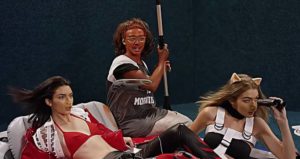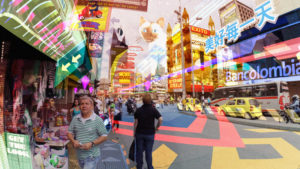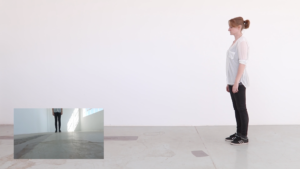 Attend: Program Notes
Attend: Program Notes
OFF THE WALL Video Art Series, 2017 Edition, Night Two
Arts + Literature Laboratory, 2021 Winnebago Street, Saturday, August 12, 8:30pm»
James Kreul previews the second night of the OFF THE WALL video art series at Arts + Literature Laboratory, and laments that Madison hasn’t kept up with contemporary experimental media.
As with last week’s OFF THE WALL preview, these notes do not constitute a neutral review. You should go to each and every one of this year’s OFF THE WALL screenings, every remaining Saturday in August at the Arts + Literature Laboratory. The Madison Film Forum is proud to play a small role in the series (mainly getting the word out), but be sure to thank Simone Doing and Max Puchalsky (Simone and Max) for reviving experimental media screenings here in Madison.
Has Success Spoiled Ryan Trecartin?
One short video this week demonstrates how important it is to keep up with what’s going on out there through programs like OFF THE WALL. I haven’t seen as much of Ryan Trecartin‘s work since I BE AREA (2007) as I would have liked, but I know he and his partner Lizzie Fitch have continued to grow in stature in the video and gallery art worlds. Trecartin’s videos I’ve seen play out as if all of the high strung, extroverted theater kids from high school got a camera and a full makeup kit and had a improvised, hyperkinetic, kaleidoscopic playdate. The energy is infectious, and almost exhausting. But at his best, Trecartin has much to say about the intersection of media ecologies and fluid contemporary identities.
Saturday’s screening will feature Trecartin and Fitch’s placebo pets (2016), which features that same manic energy, but introduces elements from the larger media and fashion worlds. The project was commissioned by W Magazine, which enabled Trecartin and Fitch to recruit current It Girls, Kendall Jenner and Gigi Hadid. The results provide a good example of something with formal and stylistic qualities that once seemed daring and liberating now seeming mannered trapped by its own success.
As one YouTube commenter put it, “I’m pretty sure even Kendall and Gigi had no idea wtf they were doing…” Kendall and Hadid deliver mundane lines that in past Trecartin projects would provide sharp ironies, but here they often seem, well, mundane. Much of the appeal of Trecartin’s work is the inherent sense of community conveyed by all of his collaborators and participants; here it seems like Kendall and Hadid had an hour to spare and showed up. And while past Trecartin and Fitch projects have never been exclusively about the videos—gallery exhibitions often include props and costumes, and video installations feature specially designed screening spaces—there’s something off-putting about transforming placebo pets into a W Magazine fashion spread.
Perhaps that’s unfair. I haven’t quite wrapped my head around it, and I look forward to chatting with people after the screening Saturday. I guess it depends on who has appropriated whom. Perhaps it is even more radical that Trecartin and Fitch were able to use Jenner and Hadid. Certainly the YouTube commenters were thrown for a loop and unable to process what they had seen—and would Trecartin and Fitch have reached those millennial Kardashian fans hadn’t if they hadn’t followed the Kendall Jenner click bait?
My main point here is that the short video raises a lot of questions about art and commerce that can’t be discussed unless you’re familiar with Trecartin and Fitch’s work as a whole. And you can’t be familiar with that work unless there are more venues for experimental media in Madison like the OFF THE WALL screenings.
I have to mention one more link that I found going down the W Magazine rabbit hole that influenced my response to placebo pets. In March of this year, W Magazine posted another video, “Kendall Jenner Recreates Four Iconic Pieces of Performance Art.” Despite a credited introduction by performance art scholar RoseLee Goldberg, it doesn’t take long to figure out how seriously Jenner or W are taking the project. When they mock Yoko Ono’s powerful Cut Piece with the punchline “No! That’s a $10,000 dress!,” I had to reconsider the degree to which W Magazine respected Trecartin and Fitch’s performance art influenced work in the first place.
Well, that was 600 words on a minute-and-a-half of Saturday’s screen time. Here are some shorter takes on other shorts.
 Augmented and Imagined Realities
Augmented and Imagined Realities
Two shorts feature first person POV shots exploring very distinct, visually dramatic worlds. The first is Kaiichi Matsuda’s HYPER-REALITY (2016) in which a protagonist navigates her way through Medellín, Colombia while also navigating seemingly endless embedded notifications, advertisements, and warnings. Perhaps a better title would be augmented reality, because the visual design suggests the world anticipated by William Gibson in Pattern Recognition, among other visionary artists. Kaiichi layers every inch of the frame with supplemental information for the protagonist to process while she rides the bus (“Stop here!”), walks the streets (“Clear the area!”) and shops for groceries (“We can help you lose weight!”). At one moment in the store the system must be rebooted, and in the interim we realize just how much Kaiichi has added to the frame. Perhaps the scariest thing about the sensory and information overload is that for most of us the image remains comprehensible. All of this is only a few steps away from Pokemon Go, after all, and many people seem to want us to get there as quickly as possible.
The second short dominated by point of view shots is Claire Krueger’s Passenger (2015) in which we wander though a world that recalls when as children we would build forts with blankets over chairs and whatever else we had available in the house. Unlike the grown-up world of HYPER-REALITY, however, the subjective shots seem to transform with a dreamlike logic as the hands in front of us shift between monster costume hands to construction paper cutouts with gems for fingernails. While Kaiichi packs the frame with information, Kreuger packs the frame with color and household items that have been transformed by a child-like imagination. Most of the action also has a playful purposelessness, reminding us that playtime, like dreamtime, need not be bogged down with plot.
 Three Short Shorts
Three Short Shorts
I’ll wrap this preview up with three shorts averaging under three minutes each. They have very little in common, except that they explore a limited set of parameters in either simple or complex structures.
The opening moments of Kuo Ying Hsiu’s Repeat Repeat (2016) might set up the expectation for a traditional dance film (if there is such a thing). We see the feet of a dancer bathed in the light of a projected abstract image. But instead of pulling back to appreciate the movements of the entire body, the shot scales remain medium and close as Kuo crosscuts and jump cuts between different parts of the dance and the body (and never showing the dancer’s face). Rhythms are created not only by the movements, but also by the abrupt cutting between ambient sounds during those movements. The static projected images also change across different shots, providing variation in density and visibility. This doesn’t necessarily add up to a constructivist whole—we never mentally piece together the whole dancer or the whole dance—instead, we cognitively assemble something new and different from all of the pieces of the filmed reality.
Toby Kaufmann-Buhler’s Kenojuak Ashevak is a deceptively simple music video featuring music by the musician known as Assembler/Responder. A hazy image of video noise slowly reveals a face, possibly a statue, possibly a mask, hard to tell due to the deliberately low-res image. The music, like the image, seems very far away, but the notes begin to cause interference in the image (recalling musical video distortions by early video artist Nam June Paik). The image continues to evolve and transition, but I’m not going to describe how specifically, other to say that despite the low resolution what happens is beautiful and moving if you allow it to be. While the hazy imagery suggests a feeling of longing for a lost time or memory, the only concrete suggestion I’ll make is that the title refers to Kenojuak Ashevak (1927-2013), a Canadian artist regarded as a pioneer of modern Inuit art.
Finally, we return where we began, with performance art. RoseLee Goldberg’s introduction to the Jenner video mentioned above of course described Chris Burden’s seminal Shoot, a performance in which an assistant shot him in the arm with a rifle. This was fresh in my mind as I began watching Nelmarie du Preez’s to shoot, and it quickly became apparent that the similarities in the title was not accidental—du Preez explicitly cites Burden as an influence in her project description. This time, however, a gun is replaced by a drone. If you know the Burden piece, it is immediately obvious where to shoot is going, but it remains extremely tense across its 1:09 running time because it is not immediately clear what the drone is capable of doing.
That covers just 6 of the 11 pieces to be showcased at OFF THE WALL on Saturday night, and I could go on for another 1500 words about the other 5 that remain. But I’d rather wait and see them with you and discuss them afterwards. I hope to see you there.